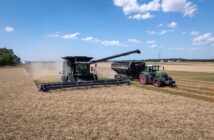AHDB held its 2023 Spring Grain Market Outlook webinar this week, here are some of the highlights of the meeting.
Looking to the new season, Megan Hesketh, senior analyst (cereals and oilseeds) said: “Large wheat supplies are expected in the EU and UK. The EU are expecting a heavy wheat balance next season, with large carry-in stocks from Ukrainian grain imports and large forecasted crops. For 2023/24, the UK’s wheat carry in stocks are currently forecast to be the largest since 2016/17, could large carry in stocks pressure our domestic harvest price? When is stored old-crop wheat going to be sold? The UK saw strong winter cropping for harvest 2023 too, and reports point to the potential for good winter grain yields with some watchpoints for disease management in winter barley. Though wet weather has delayed spring drilling. The next crop development report is provisionally forecast for release this Friday (28 April).”
Short term volatility
While short term volatility in grain markets is likely, as we head towards the renewal date on the Black Sea Initiative (Ukraine grain deal), longer term fundamentals point to a more bearish price outlook, with ample global grain supply expected for next season (2023/24). However, some key watchpoints remain, including demand– could we see rebound on lower price averages? Where will the price floor be? Weather remains crucial too as always. Finally, the renewal of the Black Sea Initiative and the war ongoing in Ukraine are things to watch going forward.
For rapeseed, a similar story in the EU can be seen. Rapeseed availability is expected to be plentiful in the new season, with a bigger crop due. On top of this, the US is also expected to be well supplied with soyabeans next season. In the UK, area is forecasted to increase for harvest 2023, though development has been variable. Some failed rapeseed area has been reseeded, to spring crops such as barley.
Like grains, watchpoints remain for price direction including the demand outlook, and the ongoing war in Ukraine. However, with northern hemisphere oilseed supply looking boosted next season, the sentiment in rapeseed markets going forward is more bearish.
Finally, in the webinar we discussed input costs and margins. Margins look squeezed for harvest 2023, with input costs remaining high but prices lower. Lead Analyst Millie Askew emphasised the need to look at farm performance to manage risk during these challenging times.




